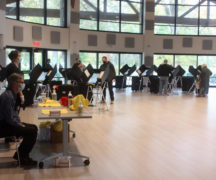BY SUSAN TEBBEN
With a week to go before Secretary of State Frank LaRose says legislative districts need to be set for the November election, uncertainty continues to mire the redistricting process in chaos.
Republican legislative leaders still can’t come to an agreement on who should be their representative as co-chair on the Ohio Redistricting Commission, creating a brick wall to mapmaking and adoption of statehouse districts needed for the general election and beyond.
Gov. Mike DeWine set a Thursday evening deadline for the GOP to work out the disagreement, and the deadline passed without agreement, according to a spokesperson for DeWine’s office.
“It does not appear the GOP legislative caucuses notified us of a co-chair appointment before 5 p.m.,” DeWine press secretary Dan Tierney wrote to media Thursday evening.
The official statement postponing the Friday meeting said public notice “will (be) issued at a later date for when the commission is set to return from recess.”
House and Senate members did not express concern about passing maps by the deadline, despite the hold up.
“Channels of communication remain open and we are confident this will be resolved with plenty of time to approve new district maps for the General Assembly,” said John Fortney, spokesperson for Senate President Matt Huffman.
Former commission co-chair and current ORC member state Rep. Jeff LaRe, R-Violet Twp., said “productive, collaborative conversations” continue to happen among commissioners.
“We’re confident we will soon move forward on the redistricting process and deliver great representation for the people of Ohio,” LaRe said in a statement.
Democrats said at Wednesday’s meeting, in which committee members were officially sworn in despite the lack of co-chairs, that they already had a plan for a fellow co-chair. They planned to wait until after the GOP decided to place their own co-chair.
The choice is one of two for the Dems, with only House Minority Leader Allison Russo and Senate Minority Leader Nickie Antonio serving for the party on the commission.
“We have no issues, the issue is not on our side,” Russo said on Wednesday.
The rest of the commission is made up of Republicans, with two GOP legislative positions, along with the Republican governor, secretary of state and auditor of state.
The delay came from an argument between House and Senate Republicans, the leaders of which couldn’t agree on which body should be represented as co-chair of the commission this time around.
Huffman said in comments on Wednesday that his chamber felt the co-chairmanship should fall to them, since the House took the seat in the last few attempts by the commission.
In September 2021, when the 10-year redistricting process began, then-House Speaker Bob Cupp served as co-chair alongside Democratic state Sen. Vernon Sykes. As the process went on, Cupp (and Huffman) left the commission to deal with other “legislative duties,” with Cupp replacing himself as co-chair with LaRe.
The confusion over who will run the commission has fouled up the timeline to get the real work done: creating legislative district maps for the sixth time. The Ohio Supreme Court rejected the last five attempts, some of which were duplicate maps, rather than maps made from scratch.
The commission abandoned the work of two taxpayer-paid independent mapmakers inserted into the process by order of the Ohio Supreme Court, saying the timetable to finish edits needed to make the maps constitutionally compliant was too short. Because of that, the commission passed previously court-rejected maps along party lines.
The most recent rejection of maps and order for the ORC to get back to the drawing board came in May 2022.
Now, LaRose says preparation for the November election is in peril if the ORC can’t get maps passed by the end of next week.
Discussions on the true deadline for elections has bounced from the hard-line opinion of LaRose to perhaps an October date, which LaRose called in his letter to commission members “the latest possible date for the commission to enact a new district plan.”
But LaRose said the Sept. 22 date would build in time for General Assembly staff to receive district maps and work up “legal descriptions” and documents for the Secretary of State’s Office to distribute to county boards of election.
LaRose was also anticipating possible litigation based on whatever map the commission adopts.
“The average time for judicial action related to each challenged district plan last year was at least six weeks,” LaRose wrote in the letter. “While I hope the Commission can approve a district plan that avoids litigation, the recent history of this process shows chaos and delay are commonly used tactics.”
Voting rights and anti-gerrymandering groups have been focused on reforming the redistricting process again, submitting a second version of a proposed constitutional amendment that would take elected officials out of the process and create an independent commission.
But they’ve reached another road block in that process, as Ohio Attorney General Dave Yost rejected the proposed ballot language for a second time on Thursday, saying reviewers “identified a critical omission that would mislead a potential signer as to the actual scope and effect of the proposed amendment.”
Yost said the language didn’t properly explain the difference between political “affiliation” when it comes to commission members versus members of a screening panel, which is important because “the key element to this new system is bipartisanship,” Yost wrote.
“In fact, the foundation of the entire system is rooted in the tempering of political power and influence with a precise balance of political or non-political affiliated members,” the letter stated. “Thus, how political affiliation is determined, who makes those determinations and what rules apply are critical issues that must be included in a summary of the proposed amendment if it is to be fair and truthful.”
The creators of the petition can choose to resubmit language again for reconsideration.
Also, from Michigan Advance

Strike! United Auto Workers declares historic strike against Detroit Three automakers
The United Auto Workers (UAW) declared a strike at midnight Thursday after negotiations for a new contract failed with “Detroit Three” auto manufacturers: Ford, General Motors and Stellantis.
This is the first time in the union’s history it has gone on strike against all three automakers. UAW President Shawn Fain told members at the picket line at the Ford-owned Michigan Assembly Plant in Wayne shortly after the strike began that the goal was never to strike; it was for companies to do the right thing by their workers.
“There’s a billionaire class and then there’s the rest of us. We’re all expected to sit back and take the scraps and live paycheck to paycheck and scrape to get by as second class citizens,” Fain said. “This isn’t just about the UAW. This is about working people in this country. No matter what you do in this country you deserve your fair share of equity.” READ MORE




